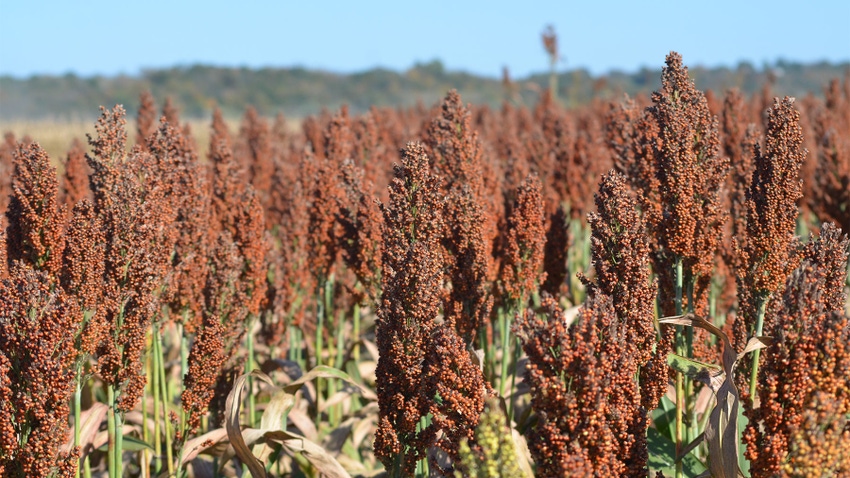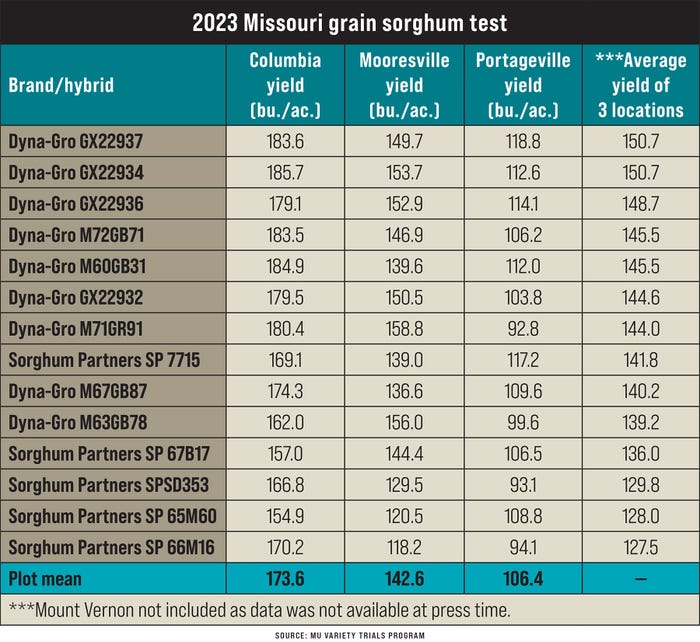
Grain sorghum yields continue to improve, and with lower input costs, it seems like a viable crop for Missouri farmers. But many are not making the switch because of a huge hiccup when it comes to selling the crop.
“When you start seeing 150- to 170-bushel-per acre yields on milo, it looks good,” says Mark Wieberg, coordinator of the MU Variety Trials Program. “The real issue we have here in central Missouri is we don't have any market to sell it. You have to go west to market it.”
Farmers on the western side of the state near Mooresville are planting more grain sorghum because they are closer to markets. And proximity can make or break a basis spread.
For some growers, it has been a while since they planted grain sorghum, or milo, on their farm. Knowing which hybrid performs best requires a little research.
MU began performance-testing grain sorghum hybrids in 1958 with 40 commercial entries. The number increased to 134 by 1982, but then it started to decrease. By 2016, there were only 19 commercial hybrids participating, so the trials stopped.
While companies conduct private testing, Wieberg notes, MU wanted to offer a public, third-party analysis for farmers. So, five years ago, the university resurrected its MU Variety Testing Program for grain sorghum.
Results are in
The grain sorghum portion of the MU Variety Trials Program is still growing.
In 2023, Wieberg secured testing locations in four locations — Columbia, Portageville, Mooresville and Mount Vernon. Only the Mooresville location in Livingston County was on a private farm; the other three were at Missouri Ag Experiment stations.
The Columbia location posted strong yields with a plot average of 173.6 bushels per acre across 14 hybrids. Topping that plot for the second year was Dyna-Gro GX22934 at 185.7 bushels per acre, an increase of 3 bushels from last year.
“That is pretty outstanding for grain sorghum,” Wieberg notes. “Grain sorghum seems to like our Columbia location.”
Production high in Mooresville was at 158.8 bushels per acre, with Dyna-Gro M71GR91. The entire plot average was 142.6 bushels.
In southwest Missouri, the plot average was 113 bushels per acre. The southeast location posted some of the lowest yields ranging from a low of 92 to a high of 118 bushels. Still, Portageville saw an improvement on overall plot yield average by 9 bushels from 2022.
Both the southern locations had problems with pests, Wieberg says.
Tackling insect pressure
Sorghum midge and sugarcane aphid affected yields for growers in southern Missouri.
Near Portageville, farmers battled sorghum midge. “That’s always an issue down there,” Wieberg says. “It wasn’t quite as bad this year, but when midge shows up, it usually knocks up to 30% of the head off the tops. It seems you’re always losing some yield to it.”
On the opposite side of the state near Mount Vernon, sugarcane aphids infested grain sorghum acres, and Wieberg says the amount of damage was “very variety specific.”
In MU’s public trial, there wasn’t much damage reported as varieties had resistant traits. However, in a nearby private on-farm trial, there were varieties crippled by the sugarcane aphid.
“There were varieties making up to 130 bushels per acre down in that area of the state,” he says. “But those that did not have good resistance were down in the 20s, 30s and 40s.”
Wieberg suggests farmers, in areas where sugarcane aphids are known to be a problem, look at planting varieties with some type of resistance.

The table on this page shows the yield possibility of grain sorghum in Missouri. For the latest information and a deeper dive into the data, visit varietytesting.missouri.edu.
About the Author(s)
You May Also Like






